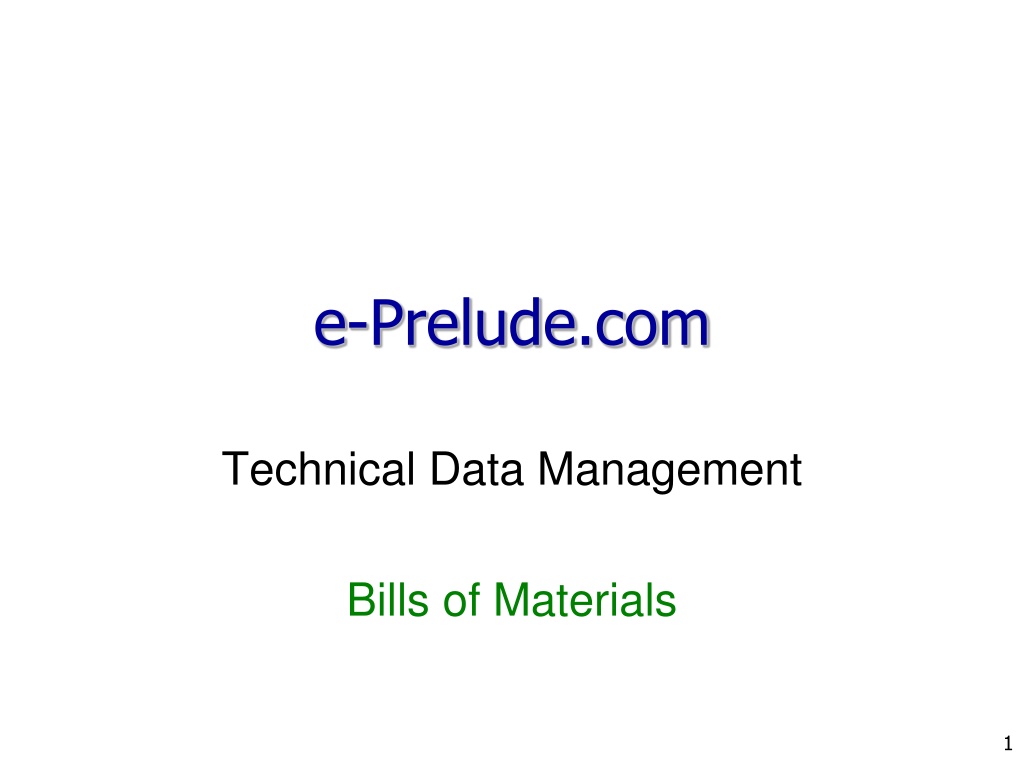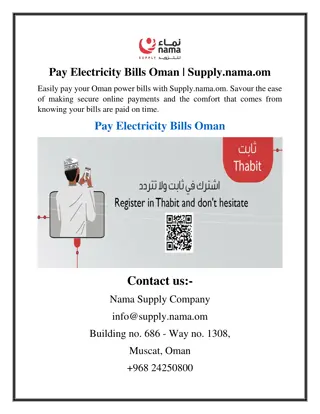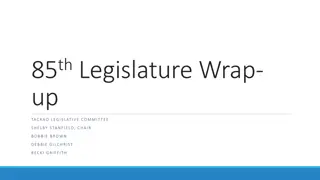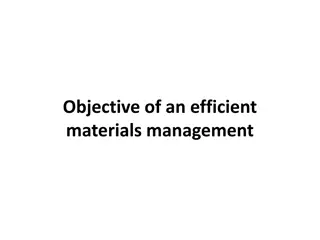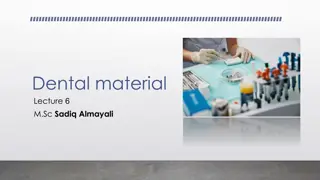Bills of Materials in Technical Data Management
Bills of Materials (BOM) play a crucial role in technical data management, recording the components needed for product creation and manufacturing processes. This content discusses the types of BOM, decimals used in BOM links, components to include in BOMs, BOM creation, and structures of Engineering and Manufacturing BOMs.
Download Presentation

Please find below an Image/Link to download the presentation.
The content on the website is provided AS IS for your information and personal use only. It may not be sold, licensed, or shared on other websites without obtaining consent from the author.If you encounter any issues during the download, it is possible that the publisher has removed the file from their server.
You are allowed to download the files provided on this website for personal or commercial use, subject to the condition that they are used lawfully. All files are the property of their respective owners.
The content on the website is provided AS IS for your information and personal use only. It may not be sold, licensed, or shared on other websites without obtaining consent from the author.
E N D
Presentation Transcript
e-Prelude.com Technical Data Management Bills of Materials 1
Bills of Materials Content BOM types Intermediate Level Creation Phantom Items Common BOM Link Offset BOM evolution By-products and co-products BOM Variants Linking components to routing operation 2
BOM decimals For each item, the number of decimals used for the coefficient of its BOM links should be specified Examples: Assembled product: 0 decimal Only an integer number of components can be mounted chemical combination: 4 decimals 0.0253 kg for a component 3
Which components should be recorded in the BOMs? Should be recorded in the bills of materials all materials and all components including waste packaging Should NOT be recorded in the bills of materials components with erratic consumption and/or with a very low cost examples: oil, stretch films, tags recyclable packaging examples: containers, pallets, ... 4
BOM types Engineering BOM created by the Product engineering department Used during product design phases and development (up to prototyping) Manufacturing BOM created by the Process engineering department maintained by the plants Budget (or Frozen) BOM Used as budget reference Created by the Frozen Data Creation function (Costing menu) Select the date for link selection Creates a copy of valid links 5
BOM types An manufactured item can have several BOMs Select the BOM type in the drop-down list 6
Engineering BOM Structure depends on Product engineering department working methods Product Breakdown usually by functions Gradual development Choices technical performance - manufacturing cost Transfer to manufacturing 7
Manufacturing BOM Structure depends on the manufacturing steps of a product Created by the Process engineering department when it enters the routings It must be verified that, at the lowest level, all the components entered by the Product engineering department are found in the manufacturing BOM 8
BOM Links New fields 9
Creating an intermediate level ? FG FG C1 C2 C3 S/A C3 C1 C2 Advantages of creating an intermediate level: 1 easier description of planning rules 2 managing an inventory is easier than managing a WIP 3 assembly which can be common to several parent items Disadvantages: have to manage an additional item 10
Rules for creating a BOM level Rules: 1 - minimize the number of levels 2 - create a sub-assembly only if inventory can exist 3 - create a sub-assembly if there is a break in the production stream 4 - create a sub-assembly if there is an independent demand (external requirements) Practice: Do not create a BOM level when the assembly operation is carried out as a result of the preceding operation (in the stream) Create a BOM level at each declared manufacturing step 11
Effects of an intermediate level Allows to grouper requirements for common sub-assemblies P1 SA1 FG P2 Receipt-Issue Transactions SA2 P3 Longer manufacturing cycle Manufacturing Cycle P1 Rake BOM (single level) P2 FG P3 ManufacturingCycle 12
Phantom Items Definition Non-storable items (ephemeral existence) Have a BOM Do not have a routing Cannot support sales forecast, Customer orders, Work orders Examples of use Structuring complex BOMs Grouping of components common to several BOMs Creation of common BOMs 13
Common BOM Principle: Two products having exactly the same components can and must use a common BOM Any change will concern both products Example: Two parts, left and right are made with one kg of material M A change (ex: using only 0,9 kg of M) will automatically concern both parts Practice: Create a phantom item to support the common BOM 14
Common BOM FG1 FG2 C1 C2 C3 C1 C2 C3 FG1 FG2 Phantom Phantom Phantom C1 C2 C3 15
Packaging BOM Packaging is indicated in a link with the finished product The coefficient represents the "fraction" of packaging used by a finished product Example: if you put 12 parts in a carton, the coefficient will be 1/12 (that is 0.0833) 16
Packaging BOM Quantity of parent items in the quantity of components specified by the coefficient 17
Link Offset Object: modify the requirement date calculated from the item lead time for some components in the BOM Negative Offset Makes it possible to introduce a safety lead time for a particularly sensitive component Positive Offset Allows to indicate that a component if not required at the release date but at the end of the process (example: packaging) Specified in days 18
Link Offset Work Order Release Date Work Order Due Date Item Lead Time Normal required component date (offset 0) Negative offset Positive offset Required component date with a negative offset Required component date of a component used at the end of the process Another solution: Attaching components at each routing operation 19
BOMs changes over time Object: Plan for future product developments (Engineering changes) Find the composition of a product manufactured in the past (After sales) Practice: Changes are identified by Validity start and end dates in product structure record Serial numbers or Engineering change notice (not supported by e-Prelude) 20
BOMs changes over time Changes are identifies by validity dates on product structure records Used in the MRP process at release date Link valid till March 21st FG Link valid from March 22nd C1 C21 C22 FG FG C1 C21 C1 C22 BOM till March 21st BOM from March 22nd 21
Mass Replacement A component can be automatically replaced by another In all its where-used parent items From an effective date Example: Replacing a purchased component 22
Options and Variants Definition: an option, it is one or several additional components a variant, it is one or several different components Object: Describe slightly different products without having to completely rewrite the BOMs 23
Options and Variants Method base + options Phantom items grouping common components Method base + variance Create as many finished products as combinations of options / variants These methods can only be used at the higher BOM level Link selection All the possible links are entered Valid links are selected using the value of an attribute (not implemented in e-Prelude) 24
Method Base + options FG220 FG110 Base Conv220 Base Conv110 FG optional component FG optional component All common components 25
Method Base + variance Base item FG220 C2 C1 Conv220 FG110 Base item variant FG220 Conv220 Conv110 (+1) (-1) C2 C1 Conv220 26
Selection of records FG Generic item C2 C1 Conv220 Conv110 On each record: a selection attribute Attr 220 110 FG-220 FG-110 FG FG Variant 220 Variant 110 Conv220 Conv110 27
By-product or co-product Object: Describe the fact that a by-product is created when the main product is manufactured Method: crate the by-product as a component Enter a negativecoefficient on the record Example: When planning 1000 products - a need for 2500 is created on the material - a negative requirement of 1000 is created on the by-product which gives rise to an inventory receipt Produit Coef. : 2,5 Coef. : -1 Material By-product 28
BOM Variants A parent item has necessarily at least one Manufacturing BOM (M) Used in the MRP process You can create one or more variants of M BOMs Can be used to update requirements of a planned order Select a name in the variant list table (Engineering menu) A BOM variant is linked to a routing Examples A component is purchased instead of being manufactured Temporary transfer of work load to a contractor 29
BOM Variants Method Create BOM Variant Table (menu Engineering, option BOM Variant Table) Create for each variant, the item BOM (Bill of Materials Maintenance page) Assign a BOM variant to Item routings (Item Maintenance page, Routing grid) The planning process will take into account the item release routing and the BOM variant attached 30
Specifying BOM Variants For each routing, it is possible to attach a BOM variant 32
BOM Variants (another solution) Create Phantom items as parent items Create BOM variants for each Phantom item Attach one of these phantom items to the manufactured item permanently (BOM of manufactured item) temporarily (for one work order) 33
BOM Variants (another solution) Manufactured item Variant 1 Variant 2 Phantoms A1 C2 C 3 C1 C2 C3 34
Attaching components to each operation Manufacturing routing Op. 010 Op. 020 Op. 030 Op. 040 Manufactured Item Material 1 S / A Material 2 It is indicated to which routing operation the component is used This information is used for Planning components requirements Components backflush at each operation 35
Attaching components to each operation Nouvelle zone 36
Attaching components to each operation WO Release Date WO Due Date Op. 010 Op. 020 Op. 030 Op. 040 Due date for components attached to operation 020 Due date for components attached to operation 030 Due date for components attached to operation 040 Due date for components attached to operation 010 and components Not attached to any operation Components Due Dates are calculated while scheduling the Work Order 37
Effects on Production Cycle P1 S/A1 FG P2 S/A2 P3 Production Cycle S/A1 P1 FG P2 P3 S/A2 Production Cycle 38
